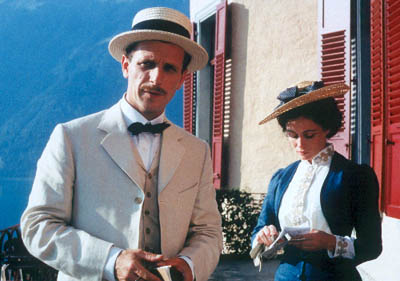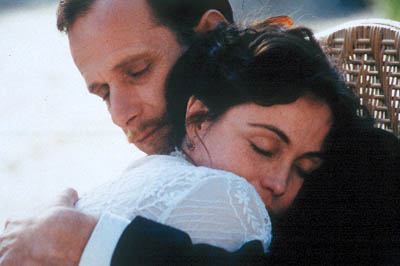

Les Destinees, based on the novel by Jacques Chardonne, spans thirty years of the Barnery family, takes three hours, and feels even longer. It has an epic length to it, but nothing in the scope of the movie justifies the marathon running time. The movie begins in 1900, and ends in the 1930s. Director (and adapter) Olivier Assayas (Irma Vep, Late August, Early September) and co-adapter Jacques Fieschi (Place Vendome, Sade) split the movie into three chapters, each approximately one hour in length. Things get better with each story, but unfortunately that requires one to sit through nearly an hour before something interesting happens. Les Destinees centers around Jean Barnery (Charles Berling, Stardom, The Bridge), the best suited to take over the Barnery business, making fine porcelain, once the time is right. However, Jean does not want to participate in the family business. He prefers the simple life of a priest.
This simple life changes when Jean believes his wife Nathalie (Isabelle Huppert, The King's Daughters, False Servant) cheated on him. He sends her and his young daughter away to the city to live. The Barnery's live in the small village of Barbizac, so everybody knows what is actually going on. The scandal forces Jean to resign from the priesthood. It is during this period that he meets Pauline Pommerel (Emmanuelle Beart, La Buche, Time Regained), the niece of Phillipe Pommerel (Olivier Perrier, The Phantom Heart, Read My Lips). The Pommerels, who are in the brandy business, are a friend of the Barnerys, and both hold considerable power in the town. Nathalie remains loyal to Jean, although she bears him no love. The story then jumps about a decade forward, where Pauline and Jean meet in London. They fall in love, marry, and then decide to live apart from the world in Switzerland. There, they live a simple, secluded life, and are more than happy by themselves. In the last portion of the film, Jean and Pauline move back to France, where Jean can fulfill his 'destiny.' He takes control of the family porcelain business amidst worker unrest, political instability, and falling prices.
Telling so much about the plot doesn't spoil anything. Les Destinees is not about the linear progression of the plot, it is more about how these things affect its characters, Jean in particular. On this point, it fares moderately well. This should be a story about Jean, Nathalie, and Pauline, and how they interconnect. Nathalie, because she is off screen for so much of the time, remains a mystery. By the time the credits roll, the most one can infer is that Pauline truly loves Jean, Jean truly loves Pauline, and Jean truly loves the porcelain business. Assayas never delves deeply into what motivates each character and who they truly are. The events should shed some light on Jean, Pauline, and Nathalie, but merely serves to move the story along at a leisurely pace. Everything remains on a superficial level.
Visually, Les Destinees is much better. Assayas has a keen eye for detail, and spends much time matching sets to time periods. A lot happens in three decades, and just by looking at the things around the actors, one can see this is true. Offices and residences start as more sumptuous and aristocratic, but become barer and more utilitarian as times change. The same goes for dress. Beart and Berling also convincingly age three decades in front of the camera. It is more than just make-up. They act and move as if they are truly older. The last part of the film goes into the porcelain business. It demonstrates how the Barnery's make porcelain, and it is fascinating to see fine plates and cups made from scratch. Assayas should have spent as much time and detail going past superficial feelings in his characters if he wanted a better movie.